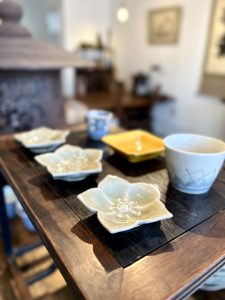長い歴史を生き抜いた焼き物でした(愛知県名古屋市千種区姫池通 骨董品買取 古美術風光舎)
2024.03.30
皆さまこんにちは。スタッフHでございます。
暖かい風に誘われて、桜の蕾もようやく膨らんできました。上ばかり見ていては危ないのですが、ついつい桜の木を見つけると見上げてしまいます。
風光舎店内も骨董祭に向け模様替えをしております。少し器の紹介をさせていただきますね。
棚の手前に並んだ三枚の小皿。桔梗の花でしょうか。青みがった灰褐色で濡れたような艶があります。山口県萩市須佐で焼かれている焼き物で、須佐焼(すさやき)、または須佐唐津焼と呼ばれるものです。

伝承によると、朝鮮半島から渡来した陶工が窯を築いたとされ、12世紀に全盛を迎えた高麗青磁や粉青沙器の三島の影響を受けていると言われています。その他に、鉄釉(黒)やビードロ釉(青、白)、藁灰釉のものもあります。釉薬の調合などの全ての工程は昔ながらの技法が使われ、代々秘伝の文書が受け継がれており、化学釉は使われていないそうです。
須佐唐津焼の開窯には諸説あるようですが、少なくとも室町時代には存在していたとのことです。
その後、毛利藩の永代筆頭家老、益田家が御用窯に取り立てて販路を広めていったとされています。
須佐という土地ですが萩市の東北部に位置し、江戸時代に入る前は小さな港町でした。なぜそのような小さな町が城下町として栄えたのでしょうか。
歴史を紐とくと、関ヶ原の戦いで敗れた戦国大名の毛利輝元が中国地方8か国から、周防と長門の2か国に減俸されたことに始まるようです。その際に家臣の益田元祥が石見の国から毛利家に追従し須佐の地に移住しました。6つの村1万2000石あまりの領地に益田家の家臣だちを住まわせ、生活の糧をえられるよう須佐を中心に街づくりを進めたようです。
毛利藩再興のための産業の一つとして須佐唐津焼を保護し、窯の拡張をはかりました。
港町でもあったことから北前船を活用し、北陸・東北・北海道まで販路を開拓していったとのことです。

萩の焼き物なのに、なぜか唐津の名前が入っているのは、唐津の陶工であった鹿郎衛門が1500年代終わりに唐津から須佐に移り住み、須佐領主の益田氏に土谷姓を与えられ御用窯となったからだそうです。現在は十四代目の土屋道仙氏が伝統の窯を継承されています。
須佐唐津古窯跡は山口県の指定史跡となっており、この窯跡で焼かれた「須佐焼」は近接する萩焼とは異なる歴史をたどったと推定されています。
昭和41年から43年に発掘調査が行われ、3基の窯跡と2か所の物原(焼成に失敗した陶磁器を捨てた場所)が発見されました。物原の下層からは「幻の須佐青磁」と呼ばれていた青磁片が出土し江戸時代前期にはこの窯で青磁が焼かれていたことが確認されています。
明治に入ると、御用窯の役目を終え販売が自由になりました。しかし交通の発達に伴い瀬戸焼や有田焼が入ってくるようになると注文が減り、大正末期までにほとんどが廃窯となりました。現在、須佐焼を製陶しているのは土谷家のみとなっており、江戸時代と変わらぬ方法で釉薬の調合や土の精製をし、ほとんどの作品を登り窯で焼成されているそうです。
いつも感じることですが、伝統を守るということは並大抵の努力ではできないことでしょう。
本当に頭が下がる思いです。
それでは、また次の機会に。
Hello everyone. This is Staff H.
With the warm breeze, the buds of the cherry trees are finally swelling up. It is dangerous to keep looking up, but I can’t help but look up at the cherry trees when I see them.
The Fukosha store is being redecorated for the antique festival. I would like to introduce a few of the vessels.
Three small plates lined up in front of the shelves. They are probably bellflowers. They are grayish brown with bluish tints and have a wet sheen. This pottery is made in Susa, Hagi City, Yamaguchi Prefecture, and is called Susa-yaki or Susa Karatsu-yaki.
According to tradition, the kilns were built by potters who came from the Korean Peninsula, and it is said to have been influenced by Mishima, the Goryeo celadon and powder blue pottery that reached its height in the 12th century. Other types of glaze include iron glaze (black), beadlo glaze (blue and white), and straw ash glaze. All processes, including glaze mixing, are said to be done using traditional techniques, with secret documents handed down from generation to generation, and chemical glazes are not used.
There are various theories as to when Susa Karatsu ware was first produced, but it is said to have existed at least as early as the Muromachi period (1336-1573).
Later, it is said that the Masuda family, the permanent chief retainer of the Mori Clan, appointed the kiln as an official kiln and expanded its sales channels.
Susa is located in the northeastern part of Hagi City and was only a small port town before the Edo period. Why did such a small town flourish as a castle town?
History tells us that it began when Terumoto Mori, a feudal lord who was defeated in the Battle of Sekigahara, was reduced from eight countries in the Chugoku region to two countries, Suo and Nagato. His vassal, Masuda Motoyoshi, followed the Mori clan from Iwami and settled in Susa. 12,000 koku of land in six villages were occupied by vassals of the Masuda clan, and the town was built around Susa to provide for the family’s livelihood.
As one of the industries for the revival of the Mori clan, Susa Karatsu ware was protected and the kilns were expanded.
They developed sales channels as far as Hokuriku, Tohoku, and Hokkaido by utilizing the Kitamae Ship.
The reason why the name Karatsu is included even though the pottery is from Hagi is because Shikaroemon, a potter from Karatsu, moved from Karatsu to Susa at the end of the 1500s, and was given the Tsuchiya family name by the Susa lord, Masuda, and became the official kiln. Currently, the 14th generation Tsuchiya Dosen continues the tradition of the kiln.
The Susa Karatsu Kiln Site is designated as a historical site by Yamaguchi Prefecture, and it is estimated that the Susa ware fired at this kiln site had a different history from the neighboring Hagi ware.
Excavations were conducted from 1966 to 1968, and three kiln sites and two monohara (places where ceramics that failed to fire were discarded) were discovered. Celadon shards known as “phantom Susa celadon” were excavated from the lower layer of the monohara, confirming that celadon was fired in this kiln in the early Edo period.
In the Meiji period (1868-1912), the role of the imperial kiln ended and sales became free. However, with the development of transportation, orders decreased as Seto and Arita ware began to arrive, and most of the kilns were closed by the end of the Taisho period (1912-1926). Today, the Tsuchiya family is the only potter still making Susa-yaki, and they continue to mix glazes and refine the clay in the same way as in the Edo period, firing most of their pieces in a climbing kiln.
As I always feel, preserving tradition is something that cannot be done by ordinary efforts.
I am truly bowled over.
See you next time.
*******************
ご実家の整理やお片付けなどをされている方のご相談などが多くございます。
お片付けなどくれぐれもご無理のないようになさってくださいませ。
風光舎では古美術品や骨董品の他にも絵画や宝石、趣味のお品など様々なジャンルのものを買受しております。
お片付けをされていて、こういうものでもいいのかしらと迷われているものでも、どうぞお気軽にご相談下さいませ。
また風光舎は、出張買取も強化しております。ご近所はもちろん、愛知県内、岐阜県、三重県その他の県へも出張いたします。
まずは、お電話お待ちしております。
愛知県名古屋市千種区姫池通
骨董 買取【古美術 風光舎 名古屋店】
TEL052(734)8444
10:00-18:00 OPEN

